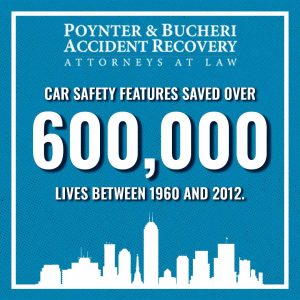
The Most Effective Car Safety Features in Vehicles

Automobile safety has evolved dramatically over the last 60 years. More and more safety features in cars have been added from 1968, when the federal government first required all new cars to include three-point seatbelts, to 2018, when backup cameras became mandatory.

Before choosing a new vehicle, you should evaluate its safety features. The most effective of them could save your life or an occupant’s.
According to NHTSA, in 2012, the average vehicle carried a 56 percent lower fatality risk for its occupants than those in the late 1950s. Car safety features saved over 600,000 lives between 1960 and 2012.
Read on to learn about the most effective car safety features available today.
Automatic Emergency Braking (AEB)
AEB is a safety feature that uses cameras, radar, or other sensors to identify potential collisions and activate the braking system. They don’t ensure you’ll avoid a crash, but they will try to stop your car in time or slow it down to lessen the impact. There are different types of AEB systems, including AEB with rear automatic braking that helps you avoid a collision when your car is in reverse, and AEB with pedestrian detection, which can help prevent crashes or lessen the impact if you strike a pedestrian or bicyclist.
Backup Cameras
In 2018, NHTSA first required all new cars to include backup cameras. Backup cameras help eliminate blind spots so you can better view the area behind you and help prevent behind-the-vehicle crashes. They often provide a better view than you would get by just turning your head.
Lane Departure Warning
Lane departure systems use a camera to recognize lane markers. If you are veering out of the lane, it will prompt you to correct your vehicle by sounding a buzzer or creating a light vibration of the steering wheel or driver’s seat.
Blind-Spot Monitoring
Like backup cameras, blind spot monitoring detects what you might have missed by looking over your shoulder and using your mirrors. These vehicle safety features use cameras mounted on your side mirror or rear bumper. If sensors identify something, they alert you with a sound or light.
Fatigue Monitoring
These systems use driver-facing cameras and computer vision algorithms to track your face and eyes. It looks for signs of fatigue, such as nodding or rotating your head or blinking your eyes. It then sounds an alert if you are tired or distracted.
Adaptive Cruise Control
Adaptive cruise control (ACC) automatically adjusts the speed of your car to help you maintain a safe following distance and stay within the speed limit. In addition, ACC helps prevent accidents from an obstructed view or following too closely. This vehicle safety feature allows you to focus on what is on the road around you rather than worrying about your speed.
Cross-Traffic Alert Systems
These systems use radar units on the corners of your car to detect anything that approaches from the sides, including pedestrians, bicyclists, or vehicles. They usually alert you about an obstacle with a sound or visual alert on the reverse camera that tells you from which direction the object is approaching.
Three-Point Seatbelts
They may not be high-tech, but they are still the gold standard. According to NHTSA, seatbelts have saved 374,276 lives since 1975.
Poynter & Bucheri: Car Accident Attorneys Who Are Here for You
Even though cars are equipped with excellent safety equipment today, injuries are still possible, and common, after a car accident. If you’ve been injured in a collision, the knowledgeable attorneys at Poynter & Bucheri can help! Contact us at 1-800-265-9881 for a free case review, including a legal opinion. We’re ready to help you take the steps necessary to get the compensation you deserve and move forward with your recovery.
